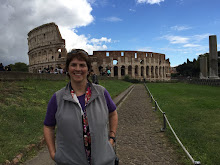Susanna Kearsley is one of those authors who digs deep into history, then spins a tale that never fails to grab me. I've read most of her novels, and was excited to see Bellewether on Sourcebook's upcoming new releases list earlier this year. I've been patient, and have been reading this on and off in between other books. I was immediately taken by the contemporary story of Charley as the new curator of the Wilde House, a historic home on Long Island; the family home of one Benjamin Wilde, a famous Revolutionary War figure. Charley's family history is also based nearby; her father rather infamously refused to fight in the Vietnam War, and fled to Canada. Her grandparents, pillars in the community, disowned him and Charley has never met or talked to her grandparents. Her brother lived in the community with his daughter Rachel, but he recently died, and Charley took the job at the Wilde House in part to help her niece navigate life without her father.
Wilde House, near a secluded cove and surrounded by a forest, is reportedly haunted by a figure that some say is a French soldier, wandering the forest with a lantern, lighting the way safely to the cove. Other rumors of murder, and a love story that ends tragically, add to the mystery of the Wilde House. Charley is there to oversee renovations, dig into the history of the house, and improve on the story of Benjamin Wilde. She is, of course, interested in finding out more about the Wilde family, and what life was like for them during the Seven Years War. The war pitted the French and the British against each other, and saw prisoners of war housed in local family homes while waiting for prisoner trades to occur between the French and the British. This was in the decade before the Revolutionary War, when Americans were still Colonists, and had loyalty to England.
The other part of the novel centers on Lydia, sister to Benjamin Wilde, and Jean-Philippe, a French solider who has been brought to the Wilde house as a prisoner of war to await trade negotiations with the British. Jean-Philippe speaks no English, and Lydia speaks no French. He's definitely seen as the enemy, and yet Lydia and Jean-Philippe can't help but develop feelings for each other. What will happen when he's finally taken away? Will he end up back in Quebec to fight again? How would Lydia's family feel if they found out about the growing attraction between the two?
The two stories, separated by centuries, but tied together by the Wilde House, work well together. The complex issues of the Seven Years War are explained well enough to be clear, but not so much that you're dragged down by a history lesson. All the little pieces of information Charley finds, along with help from an unknown spirit in the house, slowly bridge the gap between what happened in Lydia's time, and what Charley knows in today's world. But oh gosh, you just don't know until the end if Lydia and Jean-Philippe have a happy ending, or if it ends in tragedy.
I think part of what made this novel so enjoyable for me is my deep desire to actually be a curator at a historical home. That's another career that appeals to me, but I'll just have to be content to visit historical places and enjoy what others have uncovered. Lydia and Charley are both strong female characters, and both have strong counterparts in Jean-Philippe and Sam, the expert at historical reconstruction who catches Charley's eye. Overall, a good, solid historical fiction tale with a dash of romance, a bit of the supernatural, and a whole lot of history, and how we try to create truthful stories based on what's left behind.
Rating: 5/6 for a very good historical novel with dual storylines: one set in the 1760's, another set in contemporary Long Island-and both set at Wilde House. This novel is interesting in that it delves into the Seven Years War, which I hadn't read about before. It also speaks to the importance of historic preservation, and the stories our ancestors have left behind for us to discover.
Available in paperback and ebook.



No comments :
Post a Comment